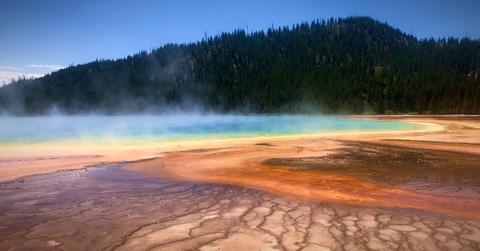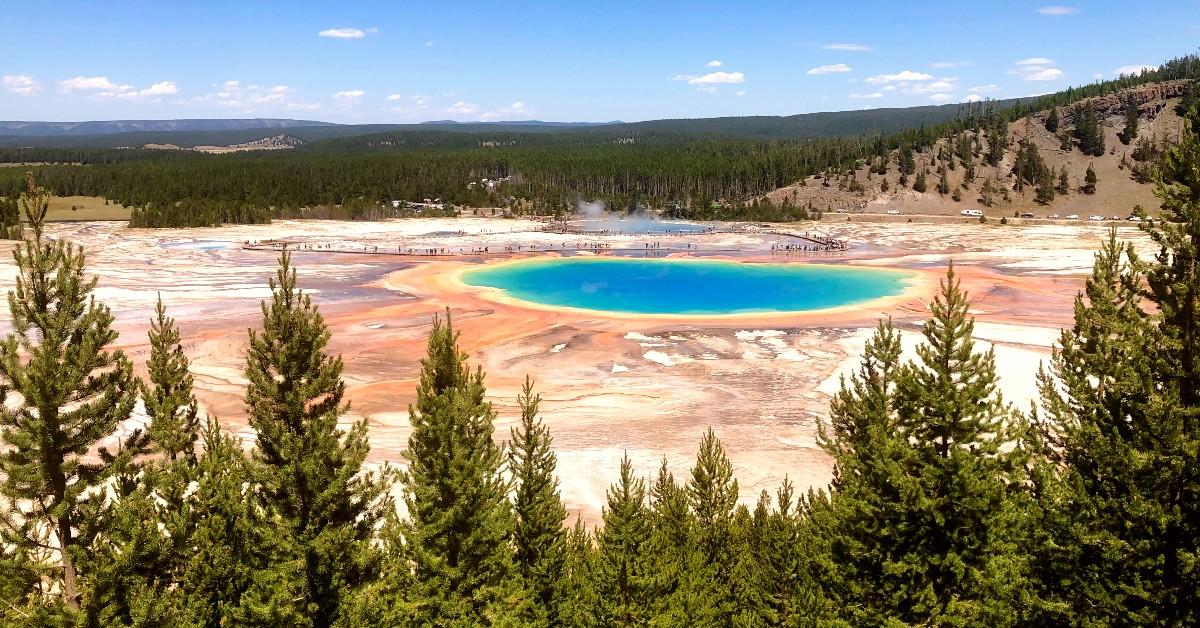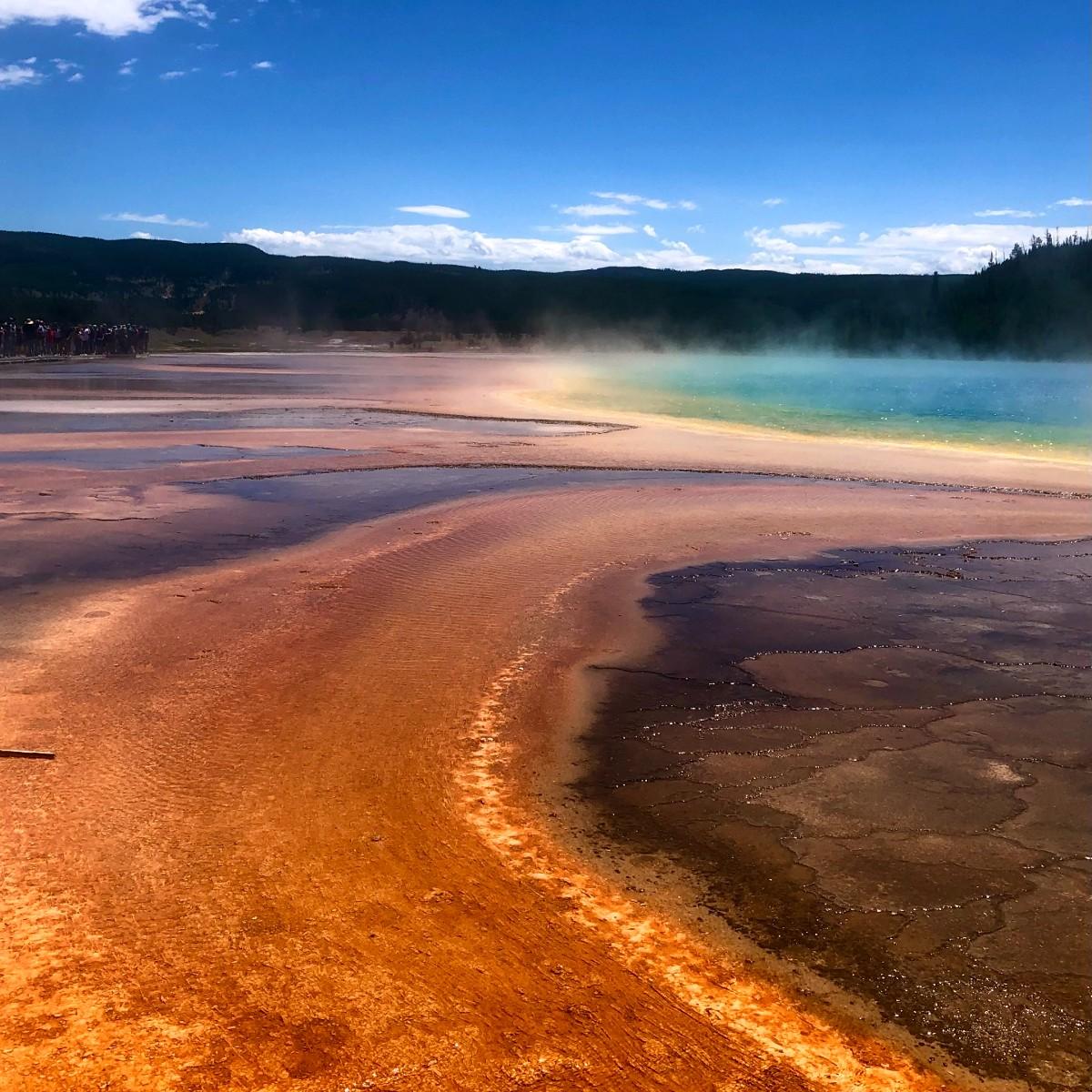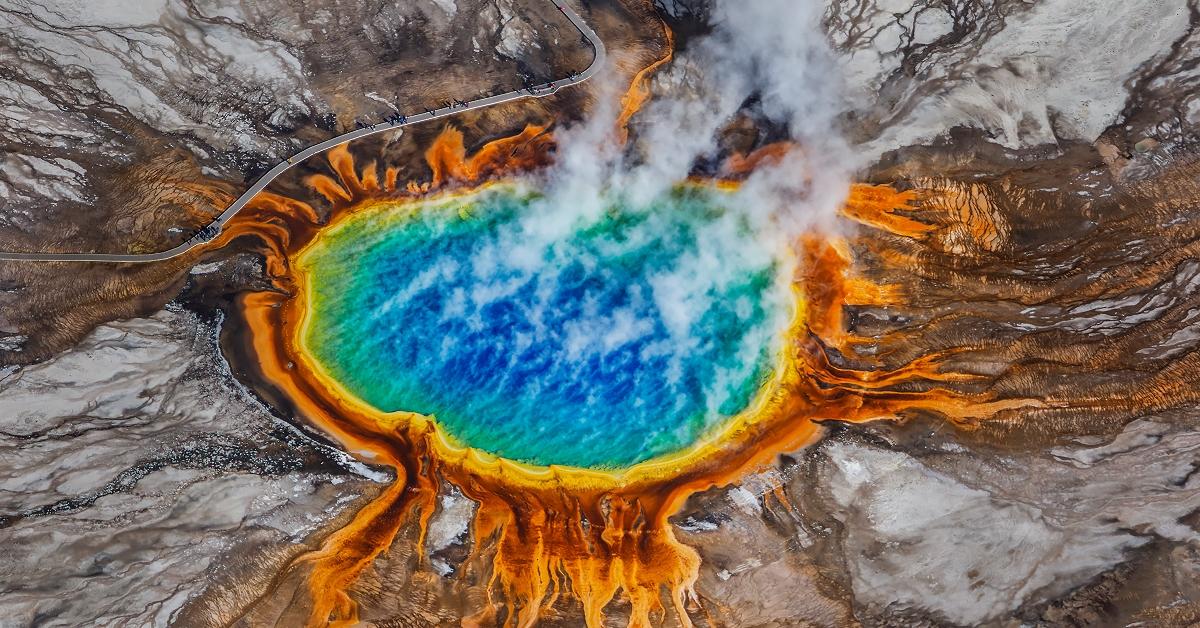Can You Swim in Yellowstone National Park's Grand Prismatic Spring? An Expert Weighs In (Exclusive)
Published Aug. 29 2023, 3:38 p.m. ET

Just five minutes in the verdant, mountainous oasis that is Yellowstone National Park can heal all wounds and traumas — a rebirth for those infected with the poison of the internet, the media, and rise-and-grind culture. What? Does touching 2.2 million acres of grass and rock not have this effect on you? In all seriousness, the Montana-, Idaho-, and Wyoming-based park — which became the U.S.'s first national park in 1872 — is a wondrous intact ecosystem.
And though it's virtually untouched in terms of construction and deforestation, people can't help but, well, touch it. From its dotting of hydrothermal sites to its gorgeous wildlife (bison, and moose, and bears, oh my!), park visitors have a history of getting too close for their own good. Whether they're petting the fluffy Western cows (aka the bison) or dipping their vulnerable fingertips into the not-so cool waters of the Silex Spring, a slew of risk-takers have experienced the wrath of Yellowstone.
And while the answer may be obvious to hiker extraordinaires, wilderness newbs have surely asked themselves, "Can you swim in Yellowstone's Grand Prismatic Spring?" The ecological marvel is one of "over 10,000 active hydrothermal features formed by the interaction of ground water with the heat remaining from the ancient volcano that formed Yellowstone," per a 2022 article published in the scientific journal Nature.
Those rainbow waters do look enticing — refreshing even. Well, since Yellowstone tragedies continue to fill our newsfeeds in 2023 — even with ceaseless warnings from park rangers and generous signage — we had a Yellowstone researcher break down the dangers of the park's hydrothermal wonders.
In an exclusive e-interview with Green Matters, third-year University of Wyoming Ph.D. student Andrew Miller discussed the hidden life in Yellowstone's Grand Prismatic Spring, the inherent hazards of geological curiosity, and the mysteries of the Grand Prismatic.

Can you swim in Yellowstone's Grand Prismatic Spring? You may want to put the floaties and goggles down.
A handful of summer 2023 incidents featured on the popular Tourons of Yellowstone Instagram account prove that ignorant tourism is alive and well. On one June occasion, two men were spotted walking across a prohibited landscape that touches the Grand Prismatic Spring. Per an Advnture article, the National Park Service (NPS) relayed that simply walking around the edges poses risks as "scalding water underlies most of the thin, breakable crust around hot springs."
Other summer 2023 events saw curious visitors touch the surface of the Silex Spring — one of the hottest springs in the Fountain Paint Pot area — as well as the surface of the murky Green Dragon Spring.
Grand Prismatic temperatures range from 145.4 to 188.6 degrees Fahrenheit, according to the National Science Foundation, and the Silex Spring has an average temperature of 174.7 degrees Fahrenheit. While Green Dragon Spring temperatures are not as readily available, the NPS stated that "steam frequently fills the cavern of this intriguing hot spring" and "visitors must wait patiently for a glimpse of the sulfur-lined cave and boiling green water."
In other words, heck no, you cannot swim in the Grand Prismatic, or any other Yellowstone hot spring for that matter!
We asked Andrew Miller — whose research involves investigating "the chemical reactions between hydrothermal fluids and rock and the timescales over which interactions take place in Yellowstone National Park" — to weigh in on the madness. How do people still not know that Yellowstone's assortment of hot springs are fraught with risks?
"People have become accustomed to visiting natural hot springs resorts where they can get in pools and soak in the hot water, and do not understand that the temperatures of those places are drastically cooler than what is found at Yellowstone," Miller tells Green Matters.
"Many features in the park are as hot as 180 degrees Fahrenheit," he continues. "If a person were to leave an exposed part of their body in a feature for too long, or if thermal water were to reside on a person’s skin, they will rapidly develop third degree burns."
Miller defines a thermal spring as "the pooling of hydrothermal fluids once they reach the surface." This happens when "clear fracture pathways in the rock allow the hydrothermal fluids to reach the surface relatively unimpeded."
The NPS has specifically expressed that "swimming or soaking in hot springs is prohibited" and "more than 20 people have died from burns suffered after they entered or fell into Yellowstone’s hot springs."
Not only are these mystical and photogenic springs uber-hot, but many are also uber-acidic. A chilling 2016 Forbes article details the macabre decomposition process of a human body unfortunate enough to fall into one of Yellowstone's "doom pools." The scalding temperatures kill a person first, but the acidity takes care of the evidence, so to speak.
"Some of the hot springs actually have mildly alkaline waters, but many – including Norris Geyser Basin, the one the man fell into this year – are incredibly acidic, with pH values of around 2," Robin Andrews' piece reads, referring to a 2016 incident. "With such high acidity levels and at such high temperatures, even your skeleton doesn’t stand a chance."
The Grand Prismatic is far more basic, however, with pH values ranging from 5 to 9. Regarding the temperature and pH ranges at the Grand Prismatic Spring, each value corresponds to a different color ring.
What do the Grand Prismatic Spring's color rings mean? Let's talk microbes.
The Grand Prismatic's mesmerizing color bands actually hold communities of bacteria. "The various colors that can be seen around Grand Prismatic and features around the park are different lifeforms," Miller explains.
"Yellowstone is host to one of the widest ranges of microbial communities — especially extremophiles — seen on Earth," he adds.
For context, the National Oceanic and Atmospheric Administration defines extremophiles as "organisms that live in 'extreme environments,' under high pressure and temperature." Hydrothermal vents are considered extreme environments.
"Picture the tree of life. Life is made up of three types of lifeforms: Eukaryotes (humans, plants, animals, et cetera), archaea, and bacteria. Each form of life exists in particular conditions and needs to metabolize specific nutrients to survive. For example, humans can comfortably live from ~40 degrees Fahrenheit to ~100 degrees Fahrenheit. However, we have developed ways to survive in more extreme conditions. We need to breathe oxygen and eat (metabolize) food to generate energy, to survive each day. Archaea and bacteria have these needs as well," Miller says.
According to a 2021 paper by Anna Schwenn, the Grand Prismatic's "beautiful rainbow configuration is mostly derived from the bacterial phylum cyanobacteria, which includes the individual genera Calothrix, Phormidium, and Synechococcus."
"The yellows, oranges, and reds around Grand Prismatic Spring are different lifeforms in the archaea branch of the tree of life that exist across different temperature ranges. Some of these archaea found in Grand Prismatic Spring [have an] ideal temperature range of more than 180 degrees Fahrenheit, whereas others prefer cooler temperatures. However, at a certain point, the water temperature is too hot, and no life can exist, which is seen by the deep blue color," Miller explains.
Because there is very little life in the spring's blue center, the water looks crystal clear. Smithsonian relayed that the striking deep blue is "thanks to the scattering of blue wavelengths," which also make oceans and lakes appear blue.
"The archaea around Grand Prismatic Spring are also provided with the nutrients they need to metabolize for energy by the hydrothermal fluids. If the Grand Prismatic Spring stopped providing these nutrients, different life that could survive in the new conditions would take over," Miller explains.
Nearly every Grand Prismatic photo is oozing with ROYGBIV magic, but Miller says the familiar colors slightly change throughout the year. It's all about temperature.
"In the winter, the archaea around Grand Prismatic will contract in towards the spring because the outflowing water will conductively cool more quickly due to the cooler atmospheric conditions. The opposite is seen during the summer, where archaea may move slightly away from the spring because the outflowing water is not cooling quite as quickly," he explains. "The fact that the rings of color/life around Grand Prismatic are so famous is a testament to how consistent the temperature and chemistry of Grand Prismatic Spring has been since the establishment and visitation of Yellowstone National Park."

Yellowstone's Grand Prismatic Spring is still an enigma in 2023.
Sure, scientists can tell you all about the feature's thermophiles, its temperature and pH ranges, the fact that it's the third largest spring in the world (which is Miller's favorite Grand Prismatic fact), et cetera, but Miller argues that not much is known about the Grand Prismatic.
"Due to its size and the unique ring of microbial communities surrounding the pool, very few people have been able to study the feature," he says. "Given the sensitive ecosystem the microbial communities exist in, the National Park Service has preferred to preserve and protect it for the enjoyment of visitors to the park. Many scientists have supported this position as the worst thing that could happen is if a scientist’s desire to learn more about Grand Prismatic Spring led to the destruction or alteration of what makes it so special."
Human interference has altered Yellowstone's natural beauty in the past. Located in Yellowstone's Upper Geyser Basin, the Morning Glory Pool had significantly higher temperatures between the 1880s and 1940s, per a 2015 paper. Unfortunately, an accumulation of foreign objects like coins, trash, and rocks "partially obscured the underwater vent" over the course of several decades. This led to a decrease in overall temperature and a change in appearance. Once blue, the pool is now an "orange-yellow-green" shade.
"This change from blue was demonstrated to result from the change in composition of the microbial mats, as a result of the lower water temperature," the paper reads.
Miller adds that recent aerial geophysical studies of the Grand Prismatic have been conducted, "opening the door to new discoveries" with little to no human interaction.
For instance, a 2022 study, titled "Imaging Yellowstone’s plumbing system from the sky," used an "electrical and magnetic mapping technique deployed on a helicopter" to reveal secrets of the park's underground plumbing system (including that of the Grand Prismatic).

“This is the first time we’ve been able to create images of the subsurface plumbing system that feeds so many of the amazing features of Yellowstone,” USGS research geophysicist and study author Carol Finn said at the time. “It’s also one of the largest and highest-resolution airborne geophysical surveys over a hydrothermal area in the world.”
Though all human interaction with the Grand Prismatic should be kept minimal, that especially goes for nosy tourists. And if you rebellious daredevils do choose to disobey rules from Yellowstone rangers and warnings from scientists like Miller, well, you know what they say: F--k around and find out.